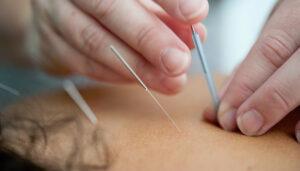INTRAMUSCULAR STIMULATION – IMS DRY NEEDLING
What is Intramuscular Stimulation (IMS)?
IMS also known as dry needling is an effective technique used by physiotherapists and physicians to treat pain arising from muscles and/or nerves. IMS is based on Western Medical Science and involves inserting a needle, without medication or injection, into an area of the muscle known as a trigger point.
A trigger point is an irritable, hard “knot” within a muscle that is painful when palpated and can produce significant pain over a large area. Trigger points are very common and can often make everyday tasks difficult and painful. They typically develop due to injuries, repetitive activity, sustained postures, muscle imbalances or a combination of factors.
How does IMS work?
A IMS works by advancing the needle into the trigger point, which causes the muscle to grab onto the needle. This is called a localized twitch response. This localized twitch response is necessary in order to deactivate the trigger point, relax the muscle and take pressure off surrounding nerves. This can result in significant pain relief, decrease muscle tension, increase movement, and promote a return to activity.
Is there scientific evidence supporting IMS?
Yes. A 2013, high quality review of several studies found IMS to be effective in providing immediate pain relief after treatment and at 4 weeks post treatment in patients with upper body muscle pain1. Other studies have shown IMS is effective for increasing movement and decreasing pain and disability in those with chronic and acute neck pain. Studies have also shown IMS to improve pain and function in persons with chronic low back pain.
How is IMS different than Chinese Acupuncture?
IMS and Chinese Acupuncture are different in theory, evaluation and application from one other. Traditional Chinese Acupuncture is based on Eastern Medicine and involves inserting needles along channels (meridians) in the body to restore ‘Qi’, or life energy. This is believed to help restore balance, decrease pain and promote healing. IMS is based on Western Medical Science and involves a thorough medical examination of the neuromuscular system. Needles are inserted directly into hyperirritable spots to decrease muscle tension at its source and release pressure off irritated nerves. With the right treatment plan, IMS can effectively treat the source of the pain and restore movement and function.
Who will benefit from IMS?
Many common musculoskeletal and sports injuries can be effectively managed with IMS. For a full list, see below. IMS has a remarkable success rate. Improvements in pain, movement and function are typically noticed after 1-2 treatment sessions. Prior to treatment, your physiotherapist will perform a thorough assessment to determine if you may benefit from IMS. Your physiotherapist may also incorporate other forms of therapy into the treatment plan, such as manual therapy, exercise and education. The total number of treatment sessions will vary from person to person based on a number of factors, such as the cause and duration of your symptoms, your lifestyle and general health.
Is IMS covered under Physiotherapy in my extended medical plan?
Yes. If your extended medical plan includes coverage for Physiotherapy, then you can claim IMS under Physiotherapy.
What conditions can Dry Needling treat?
A broad range of musculoskeletal injuries can be treated effectively with dry needling. These include, but are not limited to, the following:
- Myofascial pain (pain from muscles and tissues)
- Shin splints
- Plantar Fasciitis
- Upper back pain
- Low back pain
- Sciatica and hip pain
- Knee pain and Patellofemoral pain syndrome
- Neck pain and whiplash
- Headaches
- Tennis and Golfer’s elbow
- Shoulder pain
- Repetitive overuse injuries
- Carpal tunnel syndrome
- Sports injuries
- Chronic pain
Reference:
1. Kietrys, D. M., Palombora, K. M., Azzaretto, E., Hubler, R., Schaller, B., Schlussel, J. M., & Tucker, M. (2013). Effectiveness of dry needling for upper-quarter myofascial pain: a systematic review and meta-analysis. Journal of Orthopaedic Sports and Physical Therapy, 43(9), 620-634.
2. Llamos-Ramos, R. et al. (2014). Comparison of the short-term outcomes between trigger point dry needling and trigger point manual therapy for the management of chronic mechanical neck pain: a randomized clinical trial. Journal of Orthopaedic Sports and Physical Therapy, 44(11).
3. Mejuto-Vazquez et al. (2014). Short-term changes in neck pain, widespread pressure pain sensitivity, and cervical range of motion after the application of trigger point dry needling in patients with acute mechanical neck pain: A randomized clinical trial. Journal of Orthopaedic Sports & Physical Therapy, 44(4).
4. Gunn, C. C., Milbrandt, W. E. , Little, A. S., et al . (1980). Dry needling of muscle motor points for chronic low-back pain: a randomized clinical trial with long-term follow-up. Spine, 5:279 –91.
Related Post on Acupuncture and Dry Needling (IMS)
Acupuncture for Mental Health
In a recent article titled What Does Acupuncture Help With? the concept of mental health was addressed, among a number…
Best Acupuncture Memes for 2023
Earlier in the month, we changed the tone on our blog to create a few fun physiotherapy memes for readers to…
What Else Does Acupuncture Help You With?
You likely have a general idea about what acupuncture treats based on visuals alone. It’s easy enough to draw a…
BOOK YOUR THERAPY SESSION
Our highly qualified therapists are committed to listening to your needs and providing one on one care in order for you to feel your best!



